Book contents
- Frontmatter
- Contents
- Acknowledgements
- 1 An introduction to negotiation
- 2 The essence of negotiation
- 3 Being strategic
- 4 The process of negotiation
- 5 Managing a negotiation
- 6 Dealing with differences
- 7 Exploring options
- 8 The end-game exchange
- 9 Negotiating on behalf of others
- 10 Cross-cultural negotiations
- Appendix 1 A preparation checklist
- Appendix 2 A negotiation review checklist
- Appendix 3 Self-reflection tools
- Appendix 4 The Strategy Framework
- Appendix 5 The Nullarbor Model
- Appendix 6 Managing competitiveness
- Appendix 7 Managing workplace negotiations
- Appendix 8 Managing a business negotiation
- Appendix 9 A culture checklist
- References
- Index
Appendix 5 - The Nullarbor Model
- Frontmatter
- Contents
- Acknowledgements
- 1 An introduction to negotiation
- 2 The essence of negotiation
- 3 Being strategic
- 4 The process of negotiation
- 5 Managing a negotiation
- 6 Dealing with differences
- 7 Exploring options
- 8 The end-game exchange
- 9 Negotiating on behalf of others
- 10 Cross-cultural negotiations
- Appendix 1 A preparation checklist
- Appendix 2 A negotiation review checklist
- Appendix 3 Self-reflection tools
- Appendix 4 The Strategy Framework
- Appendix 5 The Nullarbor Model
- Appendix 6 Managing competitiveness
- Appendix 7 Managing workplace negotiations
- Appendix 8 Managing a business negotiation
- Appendix 9 A culture checklist
- References
- Index
Summary
The trans-Australian railway, which runs from Sydney to Perth, opened in standard gauge in 1970. The journey is 3961 km, making it one of the world's great train journeys. Known as the Indian Pacific, it takes three days. What makes the route distinctive is that it has the longest length of straight track anywhere in the world – 478 km in a dead-straight line (see Figure 5.3, p. 80, Chapter 5). It is this straightness that forms the basis of the imagery for our prescriptive model of negotiation.
A prescriptive model describes what ought to happen for a good outcome to be achieved. It may be a bit idealistic but if it also has a degree of realism – which this one does – then it can help us negotiate better.
The Nullarbor Model recognises the competitiveness of negotiation but seeks to emphasise the importance of moving a negotiation through phases and to spend as much time as possible in cooperative problem-solving activities. The underlying premise is that if the right steps are followed then the process of cooperating in finding solutions is quite straightforward and will yield a good quality outcome to meet the needs of the parties. However it is not an idealistic ‘win-win’ model; the journey to Perth might not be completely straightforward.
We start the journey at Sydney.
The Nullarbor Model
Getting started: preparation
The Indian Pacific is not the only way to get to Perth. You can drive(!) or go by plane.
- Type
- Chapter
- Information
- Effective NegotiationFrom Research to Results, pp. 179 - 184Publisher: Cambridge University PressPrint publication year: 2009



